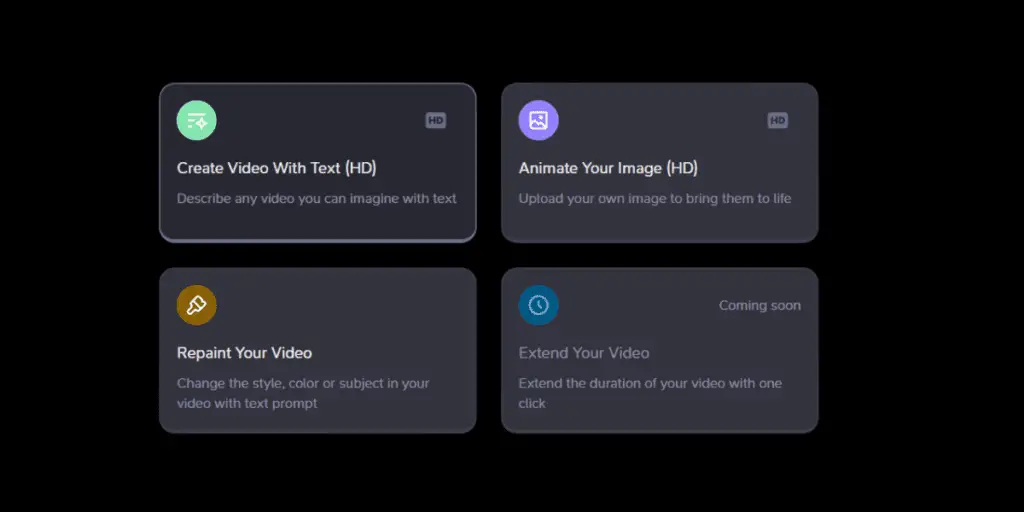Haiper AI Text to Video Technology a cutting-edge AI model developed by alumni from Google DeepMind and TikTok and top academic researchers, promises to democratize video production by enabling users from all walks of life to generate high-quality video content effortlessly.
This innovation comes at a crucial time, shortly after introducing OpenAI’s Sora, signalling a burgeoning race to dominate this niche.
Haiper’s introduction not only reflects the growing competition among tech giants to harness AI in creative and practical applications but also underscores AI’s potential to make sophisticated digital media creation accessible to everyone.
Haiper AI Text to Video Technology
Haiper is an innovative visual foundation model that seamlessly integrates advanced machine learning technologies to provide a user-friendly platform for generating video content.
Conceived by a team of experts with roots in Google DeepMind, TikTok, and esteemed academic institutions, Haiper was launched with the vision of making creative video production accessible and enjoyable for individuals regardless of their technical expertise.
The model is designed as an all-encompassing tool for digital creativity, offering features like text-to-video conversion, animation of static images, and video repainting tools.
This versatility makes Haiper a powerful tool across various industries, from entertainment and marketing to education and beyond. By simplifying the video creation process, Haiper encourages users to explore their creativity without the traditional barriers associated with video production.
Founded by Yishu Miao and Ziyu Wang, Haiper was officially introduced to the public in early 2024 after significant development and refinement.

The company is headquartered in London and continues developing and enhancing its capabilities.
Haiper’s mission is rooted in the belief that technological innovation should be fun, surprising, and shareable. Its broader aim is to pave a new path toward artificial general intelligence, a level of AI that exhibits human-like intelligence and learning capabilities.
As Haiper steps into the competitive arena of AI-driven video generation, it positions itself as a key player with a unique blend of advanced technology and user-centric design. It promises to transform how we think about and create video content in the digital age.
Founders and Their Background
Haiper is the brainchild of Yishu Miao and Ziyu Wang, two distinguished scholars with deep roots in the field of machine learning and artificial intelligence.
Both founders bring a wealth of experience and expertise from their time at some of the world’s leading technology companies and academic institutions.
Yishu Miao has a robust background in artificial intelligence. He previously worked at TikTok’s Global Trust & Safety team, where he focused on applying AI to enhance the platform’s safety protocols.
His work at TikTok was pivotal in developing AI systems to identify and mitigate risks, improving user experience and safety.
Ziyu Wang has an equally impressive track record. Before co-founding Haiper, Wang was a research scientist at Google and its renowned AI research arm, DeepMind.
His work centred around developing advanced machine learning algorithms, contributing to significant breakthroughs in the field.
Wang’s research has been instrumental in pushing the boundaries of AI capabilities, particularly in the context of learning and adaptation.

Both Miao and Wang are PhD graduates from Oxford University, where they specialized in Machine Learning.
This academic background provided them with a solid foundation in theoretical and practical aspects of AI, equipping them with the skills necessary to innovate and lead in the tech industry.
The duo began collaborating on their venture in 2021, and by 2022, Haiper was formally incorporated in London.
Their shared vision for Haiper was clear: to create a powerful, industry-agnostic tool that enhances creativity and makes advanced video production accessible to a broader audience.
Their commitment to democratizing AI-driven content creation is evident in Haiper’s design and functionalities, making it a pioneering tool in the journey towards artificial general intelligence.
Features and Capabilities
Haiper stands out in the burgeoning field of AI-driven video creation through its innovative features and capabilities, designed to make high-quality video production accessible and user-friendly.
Haiper allows users to input text prompts, which the model converts into brief high-definition videos. This feature is compelling for creators looking to quickly bring conceptual ideas to visual life without the need for extensive video editing skills or software.
Users can animate static images, giving life to still photos by adding subtle movements or transformations. This tool can enhance storytelling by creating dynamic visuals from ordinary photos.
This feature enables users to alter or enhance existing videos. Whether adjusting colours, modifying backgrounds, or applying artistic effects, Haiper’s video repainting tools allow for high customization in video projects.
Haiper’s platform is designed to be intuitive, allowing anyone, regardless of their technical background, to start creating videos immediately. The interface simplifies the video creation, reducing the learning curve typically associated with advanced video production tools.
Initially, Haiper supports the generation of HD videos that are up to two seconds long. While currently limited in length, these videos maintain a high quality and are suitable for various professional and casual applications.
For longer content, Haiper offers slightly lower quality options, which can extend video duration to four seconds, providing a balance between quality and length based on user needs.
As part of its community-building initiative, Haiper initially allows users to use the platform for free, encouraging widespread adoption and feedback. This open approach fosters a community of creators and provides valuable insights for further refining the model.
Haiper’s founders have indicated plans to extend the model’s capabilities, including increasing the length and quality of the videos it can produce. This development is expected to keep Haiper at the cutting edge of AI-driven video creation technology.
Haiper’s blend of powerful AI, ease of use, and commitment to continual improvement makes it a significant tool in digital content creation. It empowers users to explore and expand their creative horizons like never before.
Current Limitations
While Haiper introduces revolutionary capabilities in AI-driven video creation, it has limitations. Addressing these challenges and executing future plans are critical priorities for the company as it seeks to enhance and expand its offerings.
Currently, the maximum length for high-quality videos is limited to two seconds. Although a lower-quality option allows for videos up to four seconds, these constraints may restrict the applicability of Haiper for more extensive or detailed storytelling and content creation needs.
Early user experiences, like when a dog was depicted using an iPhone while surfing in a desert, revealed visual imperfections such as textures resembling creased fabric and elements appearing less refined, like a melting tail.
These issues highlight the challenges in achieving completely realistic video outputs.

As a newly launched platform, Haiper’s scalability in handling many simultaneous users and complex prompt requests still needs to be tested. This scalability is crucial for maintaining performance as the user base grows.
Haiper is actively working to increase both the length and the quality of the AI-produced videos. Extending the length of the videos is particularly critical for making the tool more useful for professional content creators who require longer segments for effective storytelling.
In response to feedback about visual imperfections, Haiper plans to improve the AI’s understanding of textures and object interactions within videos. These enhancements aim to produce more realistic and visually appealing outputs.
Haiper has initially made its platform free to use, attracting a broad user base and opening channels for extensive feedback. This feedback is crucial for iterative improvements and aligning product development with user needs.
While the tool is free, the founders are considering a subscription model. This would generate revenue while offering value through advanced features and capabilities.
Over the next few months, Haiper plans to develop and release a series of large trained models. These models are expected to enhance the tool’s capabilities and offer more sophisticated video generation options to meet its users’ diverse needs.
Haiper aims to address its current limitations and solidify its position as a leading tool in AI-driven video creation through these planned improvements and a focus on community-driven development.
The company’s proactive approach to innovation and user engagement sets the stage for significant advancements in creating and consuming video content.
Comparison with Competitors
Haiper enters the competitive landscape of AI-driven video creation tools, it faces formidable opponents, including established giants like OpenAI.
Understanding how Haiper compares to these competitors is crucial for assessing its potential impact and market positioning.
Competitors like OpenAI must balance innovation with expectations, ensuring that new products like Sora meet the high standards set by their previous offerings.
This provides an opportunity for smaller companies like Haiper to be more agile and responsive to market needs.
| Feature Category | Haiper | OpenAI’s Sora |
| Availability and Accessibility | Offers immediate accessibility; users can create videos on its website for free, aimed at building a user base and collecting feedback. | Not yet available to the public, limiting direct user engagement and real-world feedback. |
| Video Quality and Length | Allows creation of up to two seconds of HD video and four seconds in lower quality, a significant limitation for longer content needs. | Specific capabilities not detailed, but OpenAI’s history suggests a focus on high-quality outputs with potentially greater length capabilities. |
| Innovative Features | Provides tools for generating videos from text, animating static images, and repainting existing videos, making it a comprehensive video creation tool. | Features beyond text-to-video are not detailed, but expected to include cutting-edge AI functionalities based on OpenAI’s history. |
| User-Focused Development | Emphasizes a community-driven development approach; the platform is free to use to refine and improve based on user feedback. | Involves phased rollouts and selective beta testing, which may not engage as broad a user base initially but aims to ensure a refined product at launch. |
Haiper’s comparison with competitors like OpenAI highlights its potential strengths in accessibility and user engagement, though it also underscores the challenges it faces in terms of video length and visual quality. As the market for AI-driven video tools evolves, Haiper’s ability to adapt and innovate will be critical in defining its success and standing in the industry.
Final Thoughts
Haiper’s entrance into the AI-driven video creation market marks a significant step in making sophisticated video production tools more accessible and user-friendly.
By democratizing the ability to generate high-quality video content from simple text prompts, Haiper is paving the way for a broader range of users to engage in creative expression and digital storytelling.
Despite facing formidable competition from established players like OpenAI, Haiper’s commitment to community-driven development and its focus on intuitive, versatile functionalities position it as a promising newcomer in the industry.
Looking ahead, Haiper’s success will largely depend on its ability to overcome limitations such as video length and quality.
The company’s proactive approach to seeking user feedback and continuously refining its model suggests a readiness to adapt and innovate.
As Haiper continues to evolve and expand its capabilities, it holds the potential to compete with giants like OpenAI and carve out a unique niche by emphasizing creativity and ease of use.
Haiper represents a dynamic and innovative force in the AI landscape that could significantly influence how video content is created and consumed.
Its journey will be one to watch as it strives to balance innovation with practicality, all while fostering a creative community eager to explore the possibilities of AI-enhanced video production.


